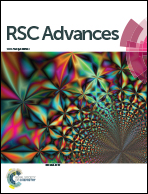pH-responsive amphiphilic block copolymer prodrug conjugated near infrared fluorescence probe
Abstract
A novel amphiphilic multi-block copolymer conjugated with both a near infrared fluorescence probe and drug has been designed and prepared by means of ring-opening polymerization (ROP) of N-Carboxy Anhydride (NCA) monomers following a Reversible Addition-Fragmentation Chain Transfer (RAFT) polymerization. At first, an amino group-containing RAFT agent was synthesized and it served as an initiator for the sequential ROP of aspartic acid β-benzyl ester N-carboxy anhydride (Asp-NCA) and ε-carbobenzoxy-L-lysine NCA (ZLLys-NCA). Then the multi-block copolymer was prepared by a succeeding RAFT polymerization of poly(ethylene glycol) methyl ether acrylate (OGEA). At the end, both anticancer drug doxorubicin and hydrophobic aminocyanine dye were chemical conjugated to the block copolymer via a hydrazone or amide bond, respectively. The obtained NIRF copolymer and its micelles were characterized by nuclear magnetic resonance (NMR), gel permeation chromatography (GPC), dynamic light scattering (DLS), and UV-vis and fluorescence spectrophotometry. The prodrug has strong fluorescence in the near infrared region and shows pH-responsive drug release behavior, and it has potential application in the theranostics of cancer.


 Please wait while we load your content...
Please wait while we load your content...